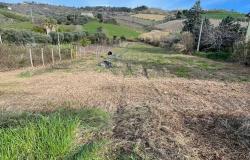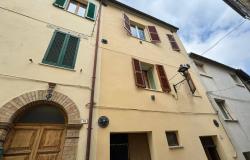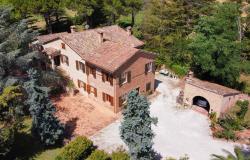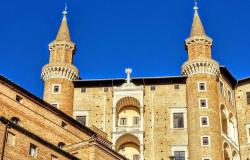Hidden away in the Appennine mountains, Urbino is a jewel of Renaissance art and architecture in Le Marche that you can reach by car or by bus from Umbria or Tuscany or from the Adriatic coast.
Urbino’s success lies in the rise to power of the Montefeltro family in the 12th Century, especially Frederico da Montefeltro who eventually claimed the throne in 1447.
Duke Frederico created one of the most brilliant courts in Italy, gathering many of the foremost thinkers, painters and architects of Europe.
Although the Montefeltro line died out within a generation of its hero, today Urbino is kept alive by the vibrant University Frederico founded and still resonates with his love of art.
Frederico's Palace
 First point of departure is Piazza Mercatale where buses arrive and there is an underground parking station. If you are facing the twin turrets of the Ducal Palace high above, slightly to your left in the corner of the piazza is a round turret. Inside is a spiral ramp designed as an access route to the Ducal stables, but you may find the elevator to the right a slightly easier option.
First point of departure is Piazza Mercatale where buses arrive and there is an underground parking station. If you are facing the twin turrets of the Ducal Palace high above, slightly to your left in the corner of the piazza is a round turret. Inside is a spiral ramp designed as an access route to the Ducal stables, but you may find the elevator to the right a slightly easier option.
Ascend to the Sanzio Theatre and up the Viale Salvalai (where there is a bar for some quick refreshment), and continue until you reach the Piazza Duca Frederico. I always make the Ducal Palace my first stop. For a mere 24 you can visit Frederico’s masterpiece that has stood as an architectural marvel for more than five centuries.
The gallery bookshop has an excellent book: Urbino: A Historical and Artistic Guide that I recommend.
The museum houses an excellent collection, highlights include Piero della Francesca’s Flagellation (described as the greatest small masterpiece in the world by John Mortimer in Summer’s Lease), the enigmatic Ideal City and a superb Raphael called La Muta.
For me the fabulously proportioned rooms, sublime courtyard bearing an inscription to the Duke’s success, and the marvellous wood-panelled Duke’s Study crown the whole experience.
Eating and Shopping
 Next stop – lunch! Urbino abounds in excellent eateries and “Il Cortegiano” is no exception.
Next stop – lunch! Urbino abounds in excellent eateries and “Il Cortegiano” is no exception.
At the rear is an intimate dining room and garden where a daily menu of homemade pastas and reasonably priced second courses is always a delight. For those with less time the bar has quick meals at moderate prices.
There are many original gallery shops with delightful creations but for traditionalist the nearby ceramic shop has the simply glazed white-ware that is unique to Urbino.
Next walk past the Imposing façade of the Duomo (not interesting enough inside to merit a stop) and down the road to the Piazza della Repubblica, the hub of Urbino.
You may wish to take an after-lunch coffee or gelato: it is worth it just to soak up the lively atmosphere of the student town and the piazza has a great energy.
Leaving the piazza, walk up Via Raffaello to Raphael’s House where the great painter was born. It has been a place of study since the 19th century. The layout of the rooms and reconstruction of the kitchen are very evocative of Renaissance houses as they once were and if you have enough time, I suggest a visit.
Fraternal Frescoes
 Now backtrack to Piazza Repubblica and take a right just off Via Mazzini and then immediately turn left. Continue along the narrow Via Barocci and at the end you will find the tiny Oratorio di San Giovanni. This is where in 1416 two brothers, Lorenzo and Jacopo
Now backtrack to Piazza Repubblica and take a right just off Via Mazzini and then immediately turn left. Continue along the narrow Via Barocci and at the end you will find the tiny Oratorio di San Giovanni. This is where in 1416 two brothers, Lorenzo and Jacopo
Salimbeni, painted some of the most incredible frescoes on the life of Saint John the Baptist. The brothers developed their local interpretation of the wondrous style known as International Gothic.
The intricate and elaborate surface patterning and the more detailed naturalism of plants, animals and fashionable costumes are combined with an elegant representation of the figures with well-mannered poise and a delightful courtly air. Please note that this gem has opening times: 10 am to 12.30 daily, and afternoons on weekdays only from 3 pm to 5.30 (Sun 10 - 12.30).
So do the tour in reverse if you are in Urbino at the weekend or on a national holiday.
The street descending from the Oratorio will take you straight down to Via Mazzini and once through the Valbona Gate you’ll have returned to the car park. You can look back at the Duke’s world and wonder how one man can affect such a major part of history and how miraculous it is that centuries after he has long gone, it still thrives.
 1: Piazzale Mercatale - parking and buses
1: Piazzale Mercatale - parking and buses
2: Ascend via Helicoidal ramp or elevator
3: Alternative routes directly up (green) or the more leisurely Via Salvalai
4: The Ducal Palace
5: Il Cortegiano Restaurant and Bar
6: Ceramic Shop
7: Piazza Repubblica
8: Raphael’s House
9: Oratorio San Giovanni
10: Valbona Gate
Art an cultural events
-
KAUS Association of international courses in engraving, illustration and book design, visit www.kaus.it
-
Festa del Duca Torneo della Cortigiania – historic procession through the town evoking the times of Frederico.
-
For more information visit www.comune.urbino.ps.it.












